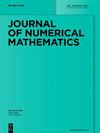利用Banach空间求解Navier-Stokes-Brinkman方程的非增广混合有限元新方法
IF 4
2区 数学
Q1 MATHEMATICS
引用次数: 4
摘要
本文考虑了用于模拟多孔介质中粘性流体的最常用非线性模型之一的Navier-Stokes-Brinkman方程,提出并分析了一种基于Banach空间的方法,并对其数值解给出了新的混合有限元方法。除了速度和压力外,还引入应变率张量、涡量和应力张量作为辅助未知量,然后利用不可压缩条件消除压力,然后根据应力和速度的后处理公式计算压力。由此产生的连续公式变成一个非线性扰动,反过来,一个扰动鞍点线性系统,然后将其重写为一个等价的不动点方程,其算子涉及将速度空间映射到自身。然后通过应用经典的Banach不动点定理,以及对数据的小假设,Banach空间中的Babuška-Brezzi理论,以及最近获得的Banach空间中摄动鞍点公式的可解性结果的轻微变化来分析它的适定性。得到的伽辽金格式是动量保守的。在适当的有限元子空间假设下,采用与连续问题类似的不动点策略,分析了该问题的唯一可解性。严格推导了先验误差估计,包括对压力的估计。我们证明了应力、速度和旋转的PEERS和AFW单元,以及应变率张量的适当程度的分段多项式,可以产生稳定的离散格式。然后,这些子空间的近似性质和csama估计暗示了各自的收敛速度。最后,我们包括二维和三维数值实验,以证实理论结果,这些试验说明了所提出的混合有限元方法的性能。本文章由计算机程序翻译,如有差异,请以英文原文为准。
New non-augmented mixed finite element methods for the Navier–Stokes–Brinkman equations using Banach spaces
Abstract In this paper we consider the Navier–Stokes–Brinkman equations, which constitute one of the most common nonlinear models utilized to simulate viscous fluids through porous media, and propose and analyze a Banach spaces-based approach yielding new mixed finite element methods for its numerical solution. In addition to the velocity and pressure, the strain rate tensor, the vorticity, and the stress tensor are introduced as auxiliary unknowns, and then the incompressibility condition is used to eliminate the pressure, which is computed afterwards by a postprocessing formula depending on the stress and the velocity. The resulting continuous formulation becomes a nonlinear perturbation of, in turn, a perturbed saddle point linear system, which is then rewritten as an equivalent fixed-point equation whose operator involved maps the velocity space into itself. The well-posedness of it is then analyzed by applying the classical Banach fixed point theorem, along with a smallness assumption on the data, the Babuška–Brezzi theory in Banach spaces, and a slight variant of a recently obtained solvability result for perturbed saddle point formulations in Banach spaces as well. The resulting Galerkin scheme is momentum-conservative. Its unique solvability is analyzed, under suitable hypotheses on the finite element subspaces, using a similar fixed-point strategy as in the continuous problem. A priori error estimates are rigorously derived, including also that for the pressure. We show that PEERS and AFW elements for the stress, the velocity and the rotation, together with piecewise polynomials of a proper degree for the strain rate tensor, yield stable discrete schemes. Then, the approximation properties of these subspaces and the Céa estimate imply the respective rates of convergence. Finally, we include two and three dimensional numerical experiments that serve to corroborate the theoretical findings, and these tests illustrate the performance of the proposed mixed finite element methods.
求助全文
通过发布文献求助,成功后即可免费获取论文全文。
去求助
来源期刊
CiteScore
5.90
自引率
3.30%
发文量
17
审稿时长
>12 weeks
期刊介绍:
The Journal of Numerical Mathematics (formerly East-West Journal of Numerical Mathematics) contains high-quality papers featuring contemporary research in all areas of Numerical Mathematics. This includes the development, analysis, and implementation of new and innovative methods in Numerical Linear Algebra, Numerical Analysis, Optimal Control/Optimization, and Scientific Computing. The journal will also publish applications-oriented papers with significant mathematical content in computational fluid dynamics and other areas of computational engineering, finance, and life sciences.

 求助内容:
求助内容: 应助结果提醒方式:
应助结果提醒方式:


